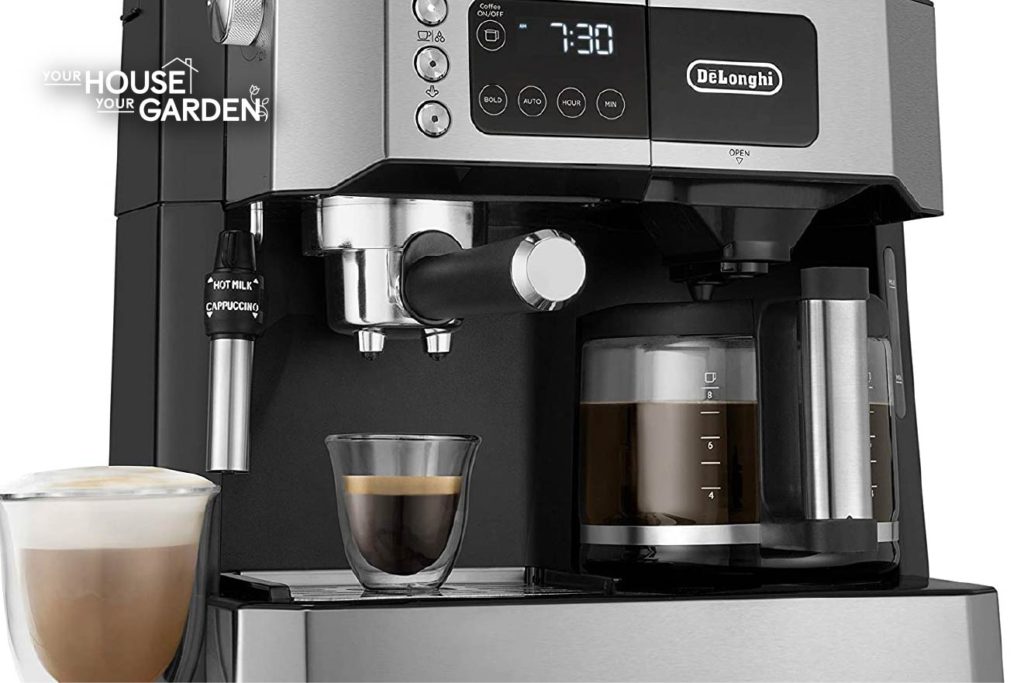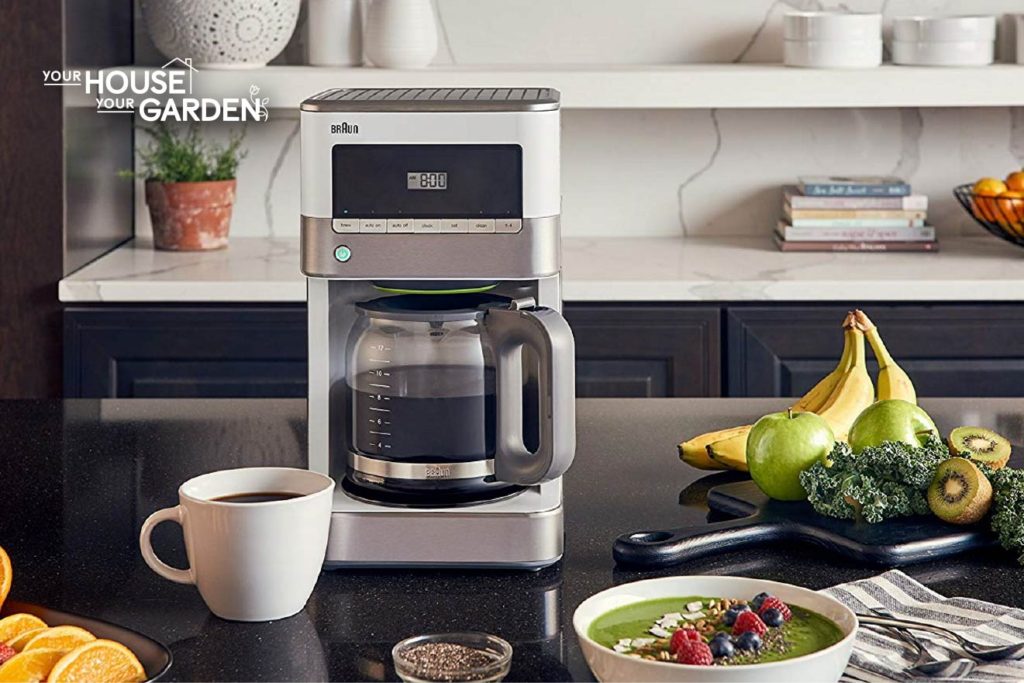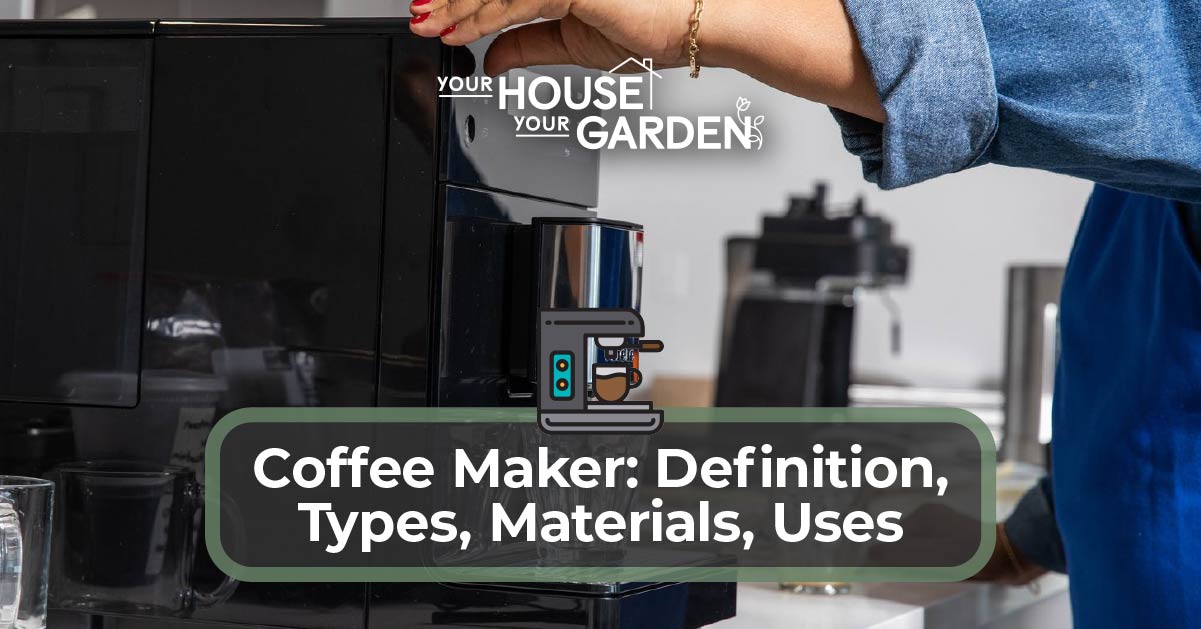A coffee maker is a small kitchen appliance used to brew coffee beans into a liquid beverage. A coffee maker can be automatic or manual.
Coffee makers come in different materials and types, including stainless steel and plastic. The preferred type of coffee maker is made with a plastic base and a glass pot. A stainless steel coffee maker is more durable but also costs more than a plastic coffee maker. A coffee maker includes a tall base with a compartment for hot water and a holder for coffee grounds.
The coffee grounds are brewed into the pot with hot water, where it drips into a glass pot or coffee cup. Some coffee makers today use pods rather than coffee grounds, which makes single-serve coffee cups.
This history of the coffee maker dates back to 1908 when Melinda Bentz made the first drip coffee maker out of blotting paper. Since then, coffee makers have improved with more features.
Materials for Coffee Maker
The best material for a coffee maker is stainless steel. Coffee makers come in other materials, like plastic or glass. A stainless steel coffee maker costs more than a plastic coffee maker but also lasts longer. Stainless steel coffee makers offer more consistent heating, which can prevent coffee from getting burnt. Plastic coffee makers may also peel or chip.
People who are worried about environmental risks may want to choose a coffee maker made with BPA-free materials, like a stainless steel coffee maker.
Types of Coffee Maker
The types of coffee makers include:
- Automatic drip coffee maker: An automatic drip coffee maker is a coffee maker that uses a filter-drip method when brewing.
- French press coffee maker: A French press coffee maker is a coffee maker that uses a plunger method to steep coffee grounds in hot water.
- Pour-over coffee maker: A pour-over coffee maker is a coffee maker where you pour hot water through coffee grounds with a filter.
- Aeropress coffee maker: An Aeropress coffee maker is a coffee maker that brews coffee using controlled temperature, total immersion, and filtering.
- Stovetop: A stovetop coffee maker is a coffee maker that gets its heat from the burner on top of a stove.
- Cold-brew: A cold-brew coffee maker is a coffee maker that cools concentrated coffee and doesn’t use heat.
- Percolator: A percolator is a coffee maker that continually cycles the heat by boiling water to make coffee.
- Espresso machine: An espresso machine is a coffee maker that uses force to get more coffee out of beans.
Sizes of Coffee Maker
Coffee makers come in all different sizes. The size of a coffee maker affects the number of coffee cups you can make each time. A smaller-sized coffee maker may only make a single-serve coffee, whereas larger ones can brew 3-4 cups per time. The size of the coffee maker can also affect how long your coffee stays hot.
If you drink multiple cups of coffee per day, you may want a larger coffee maker. If you only brew one or two cups of coffee per day, a pod-type coffee maker may be sufficient.
Does Size Affect Coffee Maker’s Usage?
The size of a coffee maker can affect how many cups of coffee you can make each time. The size doesn’t affect usage as much as the size of the coffee grounds though. Different coffee makers are capable of brewing in different sizes.
Coffee grounds that aren’t brewed as long can lead to under-extracted coffee. Under-extracted coffee can lead to a sour taste because the finer the coffee grounds, the more surface area of the coffee grounds that’s exposed. A coffee maker’s ability to brew different levels of coffee affects the types of coffee beverages you can make. Cold brew coffee uses coarsely ground coffee beans. Espresso uses finely compacted coffee grounds. Turkish coffee uses very finely ground coffee that is not filtered. French presses use thicker coffee grounds.
The cleanliness of the coffee maker can also affect the taste. Choosing a coffee maker that’s easy to clean and that won’t peel or chip can improve the flavor of your coffee.
Use Cases of Coffee Maker
A use case of a coffee maker is the specific way in which you use the appliance. Some common use cases of coffee makers include the following:
- Brew coffee
- Keep cups of coffee hot
- Warm-up soup
- Heat bottles
- Poach fish
- Melt chocolate
- Grill cheese
- Heat water for tea
- Froth milk
- Brew espresso
- Steam vegetables
Once you learn how to use a coffee maker, you’ll find that it has many uses. Some of its uses are beyond that of brewing coffee.
Do Coffee Makers Have Health Benefits?
There are some health benefits of having a coffee maker at home. The antioxidants found in coffee can be provided at home with your own coffee maker. When you have a coffee maker, you also have more control over the quality and freshness of your coffee beans and coffee, meaning you can choose a higher quality.
You also can’t control the type of coffee maker your coffee is made with when you buy coffee out of the home. Cheaper coffee makers can peel or chip off into your coffee.
Most Known Coffee Maker Brands
Some of the best coffee maker brands include:
- Best overall coffee maker: Breville
- Best value coffee maker: Cuisinart
- Best drip coffee maker: Black + Decker
- Best espresso coffee maker: De’Longhi

Coffee Maker Lifespan
The typical lifespan of a coffee maker is between 5 and 8 years. Smaller, plastic coffee makers tend to last less time than larger, stainless steel coffee makers. The factors that affect the lifespan of a coffee maker include:
- Frequency of use: How often you use your coffee maker will affect how long it lasts. If you use your coffee maker daily, you can expect it to wear out faster.
- Cleaning and maintenance: Cleaning and keeping up with routine maintenance can help your coffee maker last longer. This includes cleaning out the filter often.
- Initial quality: The initial quality of the coffee maker affects how long it lasts. Stainless steel coffee makers last longer than plastic coffee makers.
- Brand type: Even the brand can have an effect on how long a coffee maker lasts. Some brands like Breville and De’Longi cost more, but also last longer.
The average cost of a coffee maker ranges between $20 and $100, depending on the brand and features. Smaller coffee makers made with plastic materials cost less than larger coffee makers with more features. Commercial-sized coffee makers that have built-in features like milk frothers or espresso makers cost more than that.
How Does Culture Affect the Usage of Coffee Maker?
Coffee is a popular drink all over the world. However, there are differences between countries and the types of coffee beverages they drink and how they brew them. Turkish coffee is most common in Turkey. In Southern Europe and the Middle East, coffee drinks tend to be more potent with little milk or sugar. This leads to all different types of coffee makers and tools.
Some of the biggest coffee drinking cultures in the world include Italy, Slovenia, Brazil, and Germany.
Relevant Kitchen Tools to Coffee Maker
Some tools are relevant to a coffee maker, including:
- Coffee grinder: A coffee grinder is similar to a coffee maker because both appliances are necessary for making coffee drinks. A coffee grinder differs from a coffee maker because it grinds coffee beans into grounds, whereas a coffee maker brews the coffee after it’s been ground down.
- Spice grinder: A spice grinder and a coffee maker are similar because both are capable of grinding ingredients. A coffee grinder differs from a spice grinder because its primary purpose is to brew coffee beans using hot water, whereas a spice grinder grinds dry ingredients into smaller sizes.
- Tea kettle: A tea kettle and a coffee maker both heat water for beverages. A tea kettle is different from a coffee maker because it’s designed for boiling water to use a teabag with, whereas a coffee maker brews the hot water and coffee grounds together to make a beverage.
- Saucepan: A saucepan and a coffee maker are both capable of heating water, which can be used to make coffee. A saucepan is different from a coffee maker because its primary purpose is to cook food or boil water, whereas a coffee maker’s primary purpose is to brew water for coffee.
Difference Between a Coffee Maker and Espresso Machine
The primary difference between a coffee maker vs espresso machine is the method that each appliance uses when brewing coffee. A traditional coffee maker, which may be referred to as a drip coffee maker, flows water through the coffee and automatically drips it through a filter and into the cup. An espresso machine uses extra force to push through the coffee faster, leading to a thicker, more potent coffee.
Another difference between a coffee maker and an espresso machine is the time it takes to brew each. Espresso uses a faster speed than a traditional drip coffee maker, meaning it’s much faster to brew.
Features of a Good Coffee Maker
These are some features to look for in the best coffee makers:
- Brew strength: Brew strength refers to the amount of coffee pushed through the coffee filter. If you prefer coffee drinks with varying degrees of coffee, brew strength may be important.
- Smart features: Some coffee makers today come with smart connectivity features. This allows you to connect your coffee maker to your smartphone so you can pre-program your coffee each morning.
- Programmable settings: Coffee makers with programmable settings allow you to set the temperature and brew strength.
- Attached blender: Some coffee makers come with an attached blender so you can make frozen coffee drinks.
- Type of coffee grounds: Different coffee makers are capable of brewing different types of coffee grounds. Some coffee makers are only compatible with pods.
- Built-in milk frother: Coffee makers that come with a built-in milk frother allow you to make thicker coffee beverages, like lattes.
- Keep warm: Some coffee makers come with heat plates that can keep your coffee warm for hours after brewing.
- Size of coffee: The size of the coffee maker affects the size, or number, of coffee cups you can brew each time.
- Auto shut-off: A coffee maker with an automatic shut-off feature shuts it off after a while if you’re not using it.
- Removable parts: Coffee makers that come with removable parts can make it easier to clean the different parts.
- Multi-cup capabilities: Some coffee makers can brew multiple cups of coffee at one time, which is ideal for larger households.
Components of Coffee Maker
A coffee maker is made up of the following parts:
- Warming plate: A warming plate keeps the coffee warm until you’re ready to consume it.
- Heating unit: The heating unit is what heats the coffee and usually consists of a coiled wire.
- Controls: The controls and switch are what power the coffee maker.
- Pot: The pot is the part that holds the coffee.
Repair Options for a Coffee Maker
If your coffee maker stops working, you may be able to replace certain parts rather than replacing the full unit. A few replacement parts include:
- Power cord: The power cord or switch can go bad over time, especially with frequent use of the coffee maker. You may be able to replace them, depending on your unit.
- Valve: The valve can get clogged and stuck either open or closed. You may be able to remove the debris or replace the valve.
- Tube: The coffee maker tubes can get clogged with calcium deposits from the water you use when brewing. You may be able to clean them out or replace them.
- Reservoir: If you drop a glass pot, it can break. It can be easily replaced at an affordable price.

Difference Between a Coffee Maker and Percolator?
The primary difference between a coffee maker vs. a percolator is the method that each appliance uses when brewing. A coffee maker slowly brews coffee, whereas a percolator continually boils coffee until it reaches the desired strength.
Another difference between a coffee maker and a percolator is the time that it takes to brew your coffee. A coffee maker is capable of brewing coffee at a much faster rate than when using a percolator.
Coffee Maker Name Origin
The name of the coffee maker comes from its ability to make coffee. Coffee makers may also be referred to as coffee pots.
You can spell coffee maker as: C-o-f-f-e-e m-a-k-e-r.
To pronounce coffee maker, say: (Ka-fee may-kr).
Coffee Maker History
The first coffee maker was invented in 1908 by Melinda Bentz. She used a filter made out of blotting paper to make coffee. However, people have been making coffee a lot longer than that.
The first antique coffee makers were manual percolators that were heated on the stove and took much longer to brew coffee. The first electric coffee maker was invented in 1954 by Gottlob Widman. Over the years, many well-known brands have improved the coffee maker as we know it today, adding more features to create more creative coffee drinks.

